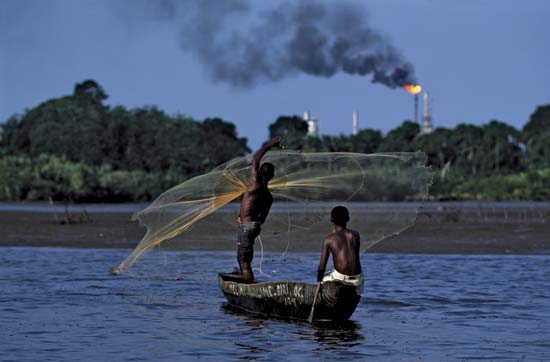Breaking News
Fishermen Along Bayelsa Coastline Lament Impact Of Oil Spill

Fishermen along the Bayelsa coastline have lamented the impact of the November 2013 oil leak from the Brass Oil Export Terminal belonging to Nigerian Agip Company, saying it had affected them negatively.
Mr Henshaw Oguike, the Chief Information Officer, National Oil Spills and Detection Response Agency, had said the leak discharged some crude into the Atlantic.
Princess Elizabeth Egbe, Chairman, Artisanal Fishermen Association of Nigeria in Bayelsa, told News Agency of Nigeria in Yenagoa, that the oil pollution annihilated fishes along the coastline.
Egbe said the development had brought untold hardship to peasant fishermen in the state because they were no longer making catches.
“The spill occurred in Brass Local Government Area of Bayelsa and over 3,000 members of my association have been compelled to suspend their economic activities,” she said.
According to her, whenever a large-scale spill occurred, the fishermen automatically suspended fishing to make way for a clean-up of the waters by the tidal waves.
“The fishes and the fingerlings were all killed by the crude; dead fishes of all sizes littered the coastline here in November and December 2013.
“The few that survived have migrated into the deep sea out of our reach.
“My people are suffering and they can’t do their fishing because if they do, their tools will be spoilt,” she said.
Egbe said that the situation had lead to scarcity of fish in Bayelsa.
She expressed regret that the oil firm responsible for the spill had not shown enough concern for the plight of the victims since the incident occurred.
The chairperson said that the fishermen had notified the oil firm about the impact of the oil leakage on them, but had yet to get any feedback.
Eni, an Italian energy firm and parent company of NAOC, had said in an online statement that it was investigating the cause of the oil leak.
Efforts to reach the spokesperson of Agip, Mr Tajudeen Adigun, through his mobile telephone and text messages failed.







Bill Reeder
2014/05/02 at 9:19 pm
Oil Spill Eater II was used to clean up this large oil spill. OSE II converts oil spill to a safe end point of CO2 and water. OSE II when applied causes oil to start detoxifying and in minutes the toxicity of the oil is lessened to reduce the spill impact to the environment. The oils adhesion properties are diminished, and the oil is caused to float so it does not adversely effect marine species living in the water column or on the seabed. OSE II was applied to the AGIP spill on the water and on the shoreline and in less than 2 weeks after the application of OSE II to the shoreline, mangroves and open water you could not tell there had ever been a spill. Shoreline testing before the spill showed signs of the oils impact, however shoreline sampling of the shoreline after application of OSE II showed the shoreline completely free of oil and wildlife was thriving. The aspect of fish dying is very limited since they will escape toxins by swimming away. In the past toxic dispersants have been used exclusively that sink oil into the water column where fish and marine species cannot escape the oil and toxic dispersants. The environmental group ERA/FoEN called for the cessation of the use of toxic dispersants, so the safe non toxic first response bioremediation product Oil Spill Eater II was used on some open water, shorelines and mangroves. The environment, and marine and wildlife species were all protected where OSE II was utilized, and a major oil spill that in the past has been a major event with damages to shorelines, was turned into a non event with AGIP’s response through Giolee Global’s application of OSE II. The AGIP oil initially covered the sensitive mangroves that protect shorelines from erosion, however the quick response with OSE II lifted the oil off the mangroves when the oils adhesion properties were diminished, and the oil was converted to CO2 and water leaving behind mangroves that were not adversely damaged from this spill. AGIP’s response saved the environment and limited environmental impact, therefore AGIP saved millions in natural resource damage fines, since there was no natural resource damages that could be determined. In less than a month after the spill you could not tell there had ever been a spill, the environment was returned to pre spill conditions turning a potential damaging event into a minimal spill. This shows that man/oil companies and the environment can co exist, when the oil company quickly responds with OSE II limiting a spills impact and virtually eliminating resource damages.